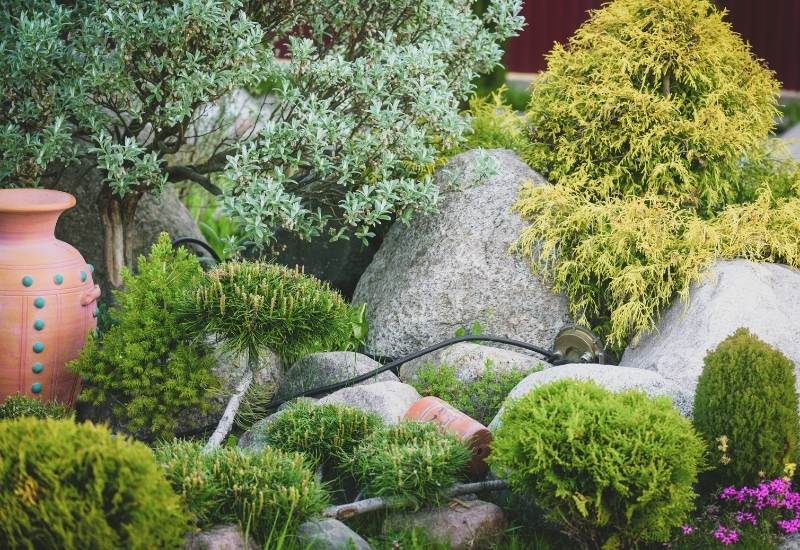
Small evergreen shrubs and dwarf varieties of evergreen shrubs can solve many problems in your garden. They will fill it with richly textured and colorful foliage all year round. They are low maintenance, and they are even excellent ground cover.
What is more, they adapt well to many types of gardens, including urban and formal gardens. And you can have firs, cypresses, pines, and other evergreens in your green space, even patio, even if it is small!
There are two main reasons why some evergreen shrubs never grow too much and remain small.
First, small evergreen shrubs are naturally short, especially those adapted to living in harsh conditions, like windy and cold places. Second, dwarf evergreen shrubs have been bred and hybridized by gardeners. Some small evergreens are dwarf varieties of larger shrubs or trees.
These low-growing evergreens have developed in cultivation and gained popularity specifically because of their limited size, while other evergreen shrubs simply have a naturally small mature size.
If you need or want an evergreen in your garden, terrace, or patio, but you only have limited space, a redwood tree is out of the question, so is a cedar, or even a cypress, come to think about it!
Small evergreen bushes are a great alternative for those who need a plant that will fit in a small space.
This article will show you some of the best and most popular small and dwarf evergreen shrubs. But we won’t stop there…
You will find details on their beauty, use and value for your garden – and how to plant and care for each one with handy tips as well!
15 Small Evergreen Shrubs For Your Garden
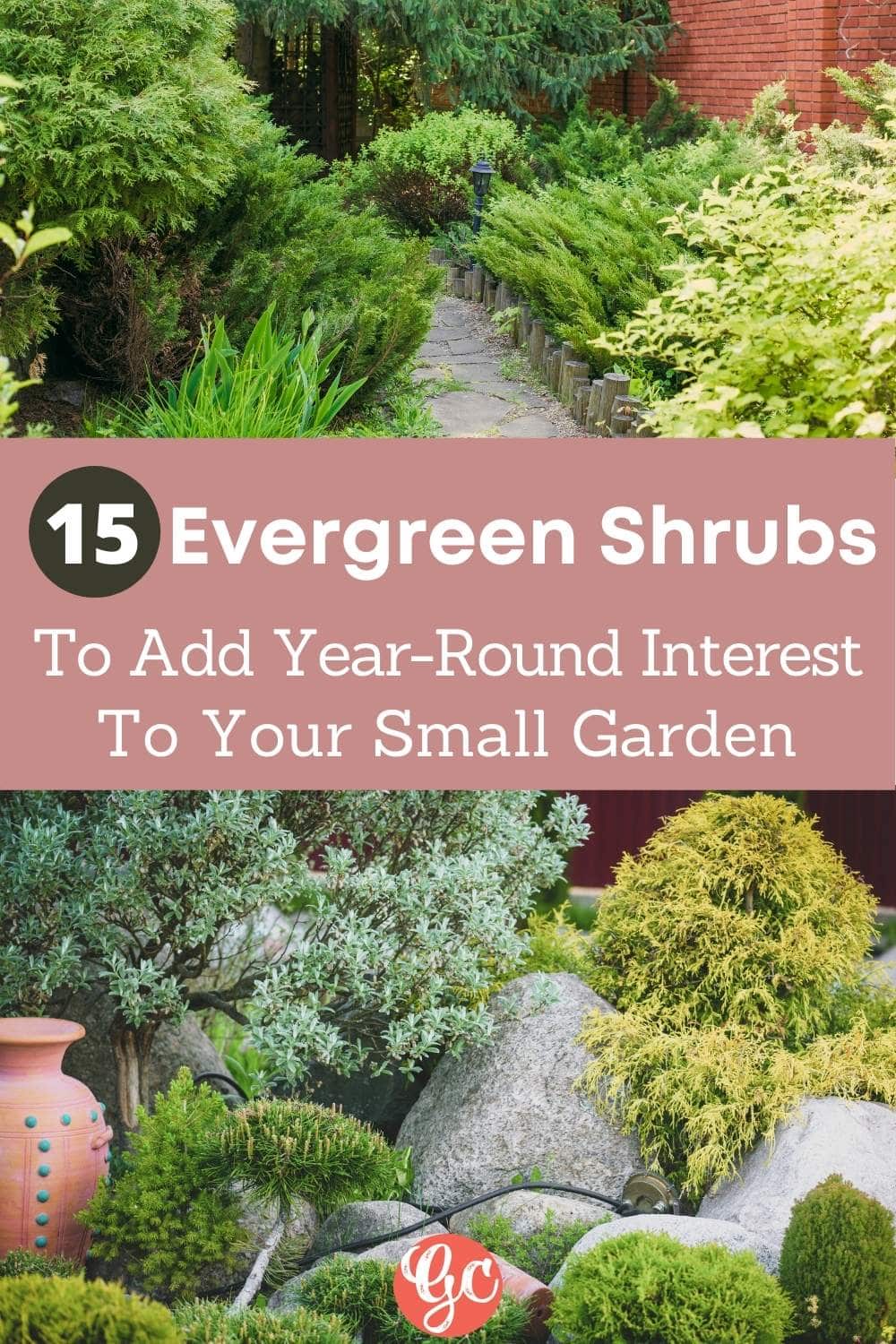
Small evergreen shrubs come in many forms. Some are coniferous, while others are broadleaf evergreens. Also, since small evergreens are in such demand, you’ll find that many evergreen shrubs arose through careful cultivation.
For each shrub on our list, you will learn what makes them great and what conditions allow them to grow best.
Here are 15 dwarf evergreen shrubs to add year round interest in your small gardens and landscapes:
1: Kalmia Latifolia (Mountain Laurel)
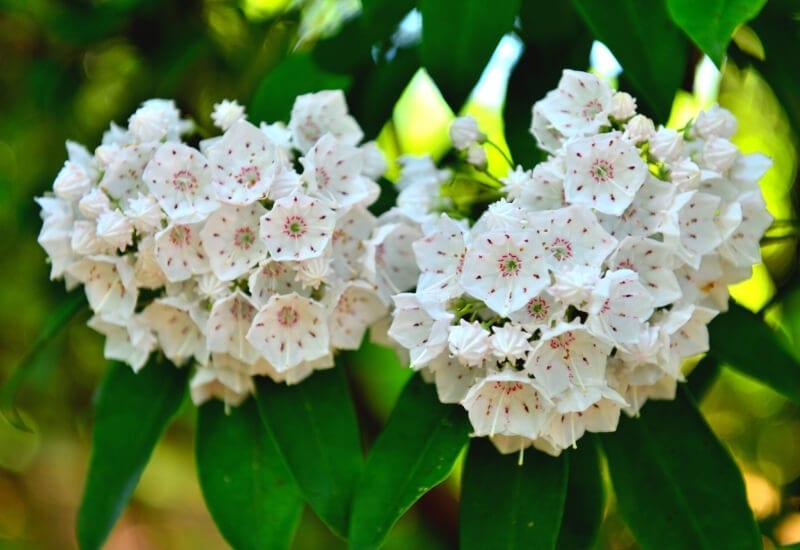
Mountain laurel is a native woodland evergreen shrub with spectacular blooms. The flowers emerge in May and June.
These flowers form clusters at the ends of the branches. Each one has an interesting geometric shape similar to a pentagon. Colors vary from white to dark pink.
Mountain laurel has broad evergreen leaves. They have a simple elongated shape and a shiny appearance.
Mountain laurel rarely expands beyond 10 feet. Instead it usually grows to around 6 feet in height and spread. It typically has a multi-stemmed growth habit.
Growing Conditions
As an understory evergreen, mountain laurel does well in a filtered shade. However, this small shrub can adapt to both full sun and full shade. Cool locations with moist acidic soils are best.
Care Requirements
You should prune mountain laurel just after the flowers fade. This includes the removal of the dead flowers. Pruning at this time gives you the most control over the shape of this shrub. Diseases are a problem for mountain laurel, especially leaf spots.
2: Thuja Occidentalis ‘Little Giant’ (Little Giant Dwarf Arborvitae)
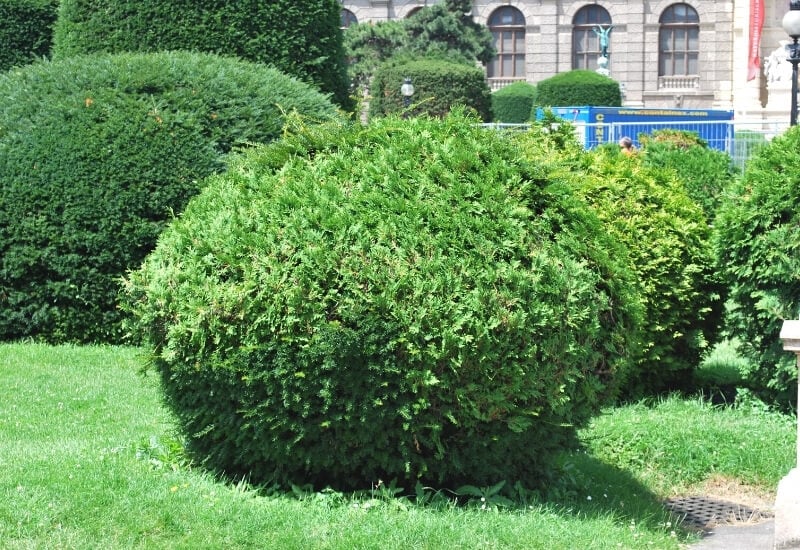
Little giant dwarf arborvitae is a cultivar of a much larger arborvitae variety. While its parent species can exceed 40 feet, this dwarf evergreen variety grows to be no more than 4 feet.
This small size is complemented by a neat, rounded form. This makes little giant dwarf arborvitae suitable for tight spaces such as foundation beds.
As with any arborvitae, the main attraction here is the consistent foliage. The leaves maintain a consistent color and texture throughout the entire year.
Otherwise, the ornamental features of this small evergreen shrub are somewhat limited. The flowers and fruits prove to be unremarkable.
Growing Conditions
Avoid dry conditions when planting little giant dwarf arborvitae. When in doubt, look for full sun as well. However, in hot regions, some shade can provide a much-needed relief.
Care Requirements
Pruning is not a major requirement for this plant. Little giant dwarf arborvitae tends to hold its rounded form with no assistance. Consider fertilizing in early spring. You should also know that this plant has a deceptively large root system. So, remember that when transplanting or digging near this shrub.
3: Ilex × Meserveae BLUE PRINCESS (Blue Holly)
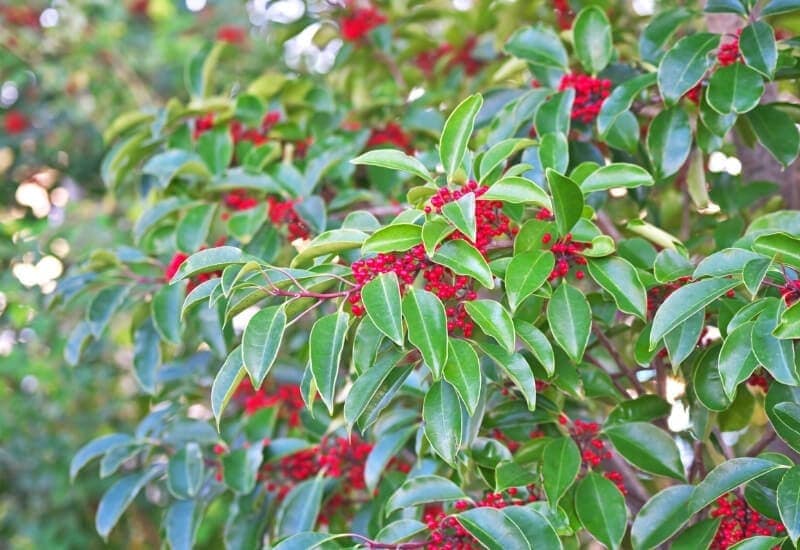
Blue holly comes with sharp evergreen leaves. These leaves are broad and glossy. Their distinctive blue-green color is the inspiration for the common name. At its maximum, this evergreen shrub is 10 to 15 feet tall.
Holly leaves are a symbol of the Christmas season in many parts of the world. These along with the persistent red berries make for great seasonal decorations.
But not all blue hollies have red berries. There are male and female versions and only the latter bears the iconic fruits. But both forms are needed for the pollination process to produce these fruits.
Overall, blue holly is a dense shrub with great seasonal interest. The ‘BLUE PRINCESS’ variety has very dark and abundant berries.
Growing Conditions
Plant blue holly in soil that is slightly acidic. Soil moisture and plenty of sunlight are essential as well. Remember that both male and female plants are necessary to produce the fruits.
Care Requirements
Blue holly has good winter hardiness but can benefit from some wind protection when the weather is exceptionally harsh. Feel free to prune for thinning and shaping as you see fit. Blue holly responds well to pruning.
4: Ilex Glabra (Inkberry)
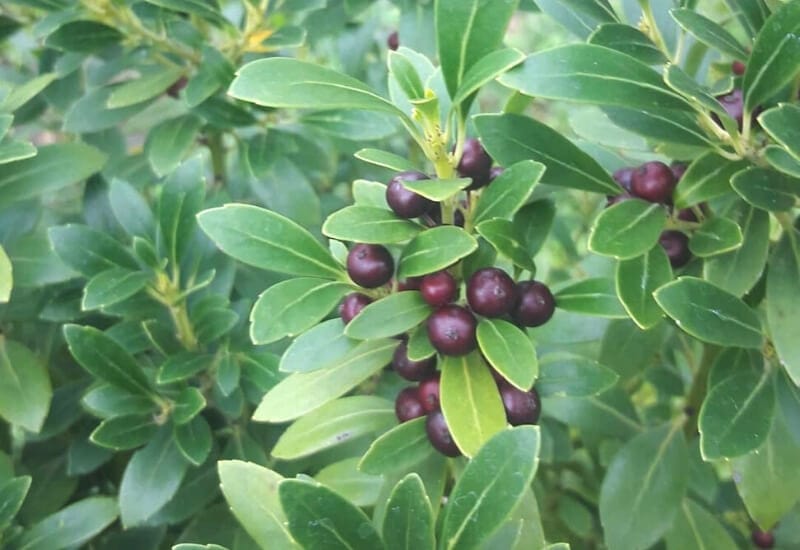
Inkberry is another broadleaf small evergreen shrub native to the eastern United States. In recent years it has become increasingly popular as a way to add reliable greenery to the landscape.
This small evergreen shrub features black fruits as the main identification feature. These drupes are about the size of a pea and are a food source for many species of birds. They also persist all the way to the beginning of the next growing season.
The leaves are small, smooth, and glossy. They have an oval shape that is about 1 inch long. They grow on upright branches that reach a maximum height of 8 feet.
Inkberry has culinary value as its flowers are needed to make gallberry honey. Native populations also brewed the leaves for teas.
Growing Conditions
Inkberry adapts to a wide range of soils. This includes survival in sandy and clay soils. It prefers moist acidic soils in full sun or part shade. Wet soils are also no issue for inkberry but high ph is a significant detriment.
Care Requirements
This evergreen spreads by suffering, so it can be hard to control at times. The remedy for this is regular pruning. This should occur in spring just before the new growth appears. This is another plant with both male and female varieties needed for fruit production.
5: Euonymus Fortunei ‘Emerald Gaiety’ (Wintercreeper Euonymus)
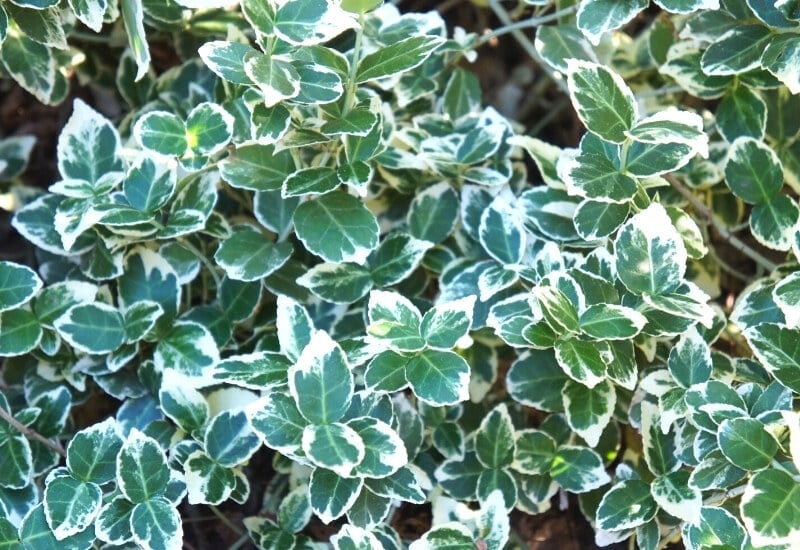
Wintercreeper euonymus is a tough evergreen with great foliage. It can also take the form of a small shrub, a groundcover, or as a climbing vine. In any case, the mature size for this evergreen is 3 to 5 feet.
Though versatile, this growth habit is almost always dense and somewhat irregular. This broadleaf evergreen is known for its intriguing foliage. This is especially true for the variety called ‘Emerald Gaiety’.
The leaves are two-toned and have a glossy texture. Their primary color is dark green. Their margins show a cream color. The cram turns to a reddish-pink tint at the end of the season.
Beyond the foliage, wintercreeper euonymus offers little in terms of ornamental value. The flowers are typically not very noteworthy. At times the flowers do not bloom at all or, only bloom in very small amounts. When they do bloom, it occurs in June with a light green color.
Growing Conditions
Plant wintercreeper euonymus in moist alkaline soils. This plant prefers full sun to part shade but will also tolerate full shade. The only soil type to specifically avoid is consistently wet soil. In many states, this plant is considered invasive so be responsible when deciding to plant wintercreeper euonymus.
Care Requirements
Wintercreeper does not have many needs. It survives in many settings and even in the presence of pollution. You can use pruning to shape this shrub as you wish. This should occur in summer after the flowers bloom. When branches touch the ground, they can take root there again.
6: Buxus ‘Green Velvet’ (Boxwood)
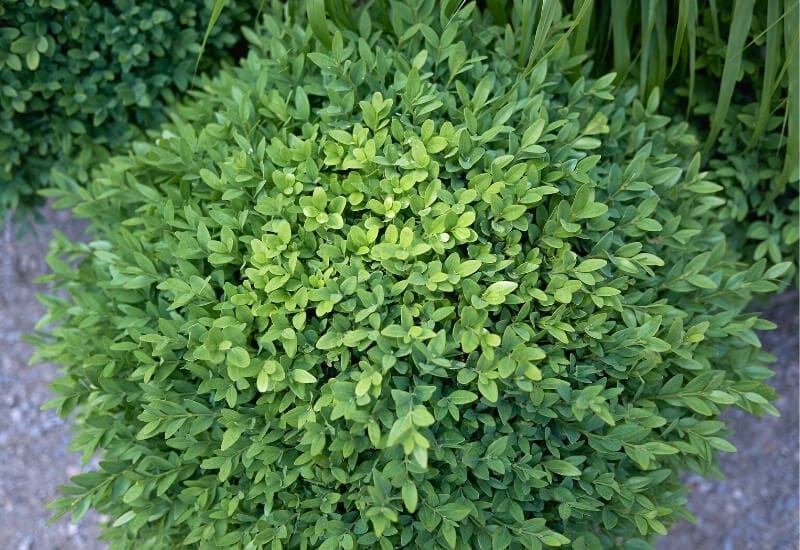
The boxwood shrubs are some of the best evergreen plants for formal hedges. You can trim these plants into many different shapes.
Because of this high responsiveness to shearing, boxwoods are one of the most common species used in parterre gardens. Sometimes gardeners even use trimming to create sculptural forms with boxwood shrubs.
The variety called ‘Green Velvet’ is great for those who want a smaller evergreen shrub variety. This plant grows to only about 4 feet in height and spread.
Boxwoods have dark, glossy, broad leaves. They are small with a curving oval shape. When left alone, this boxwood has a compact rounded shape. From this shape, you can create many different forms through shearing and pruning.
Growing Conditions
Boxwoods do well in part shade conditions. In full shade, boxwood shrubs can lose their dense growth habit. Full sun can cause damage to the leaves. The soil acidity can range from slightly below neutral to slightly above.
Care Requirements
While there is great variety in the ways you can prune and shape boxwood, there is a certain time you should do this. Only prune in the spring after the final frost from the previous winter. During winter, consider providing wind protection to prevent this plant from drying out.
7: Juniperus Squamata ‘Blue Star’ (Singleseed Juniper)
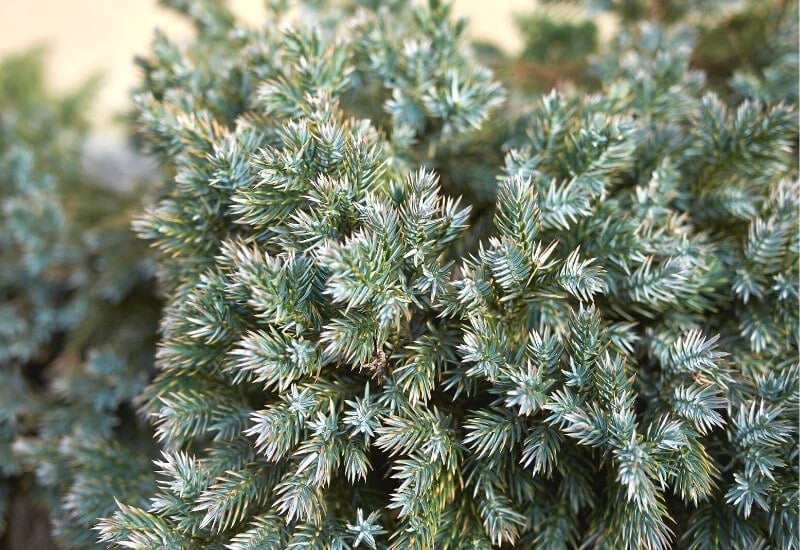
Singleseed juniper is a small evergreen with sharp needles. It is native to Central Asia and the Middle East.
This small evergreen shrub has a slow growth rate and a limited mature size. At most, it reaches 3 feet in height with a slightly larger spread. However, this plant can grow in many forms.
It can grow with an upright habit. Or it can spread low to the ground as a groundcover. Either way, singleseed juniper has short bluish-grey needles that contribute to a prickly texture.
The needles remain blue all year and have some white accents as well. The fruit is also blue. Although technically a cone, the fruit looks much more like a berry.
Growing Conditions
When planting this shrub, look for dry soils with great drainage. While singleseed juniper is adaptable to a few different soil conditions, wet soils are not acceptable.
Care Requirements
Provided that you have given singleseed juniper the conditions it needs, this plant has almost no maintenance requirements. It is highly resistant to disease. It also needs very little pruning as it tends to maintain its shape on its own.
8: Pinus Mugo ‘Aurea’ (Dwarf Mugo Pine)
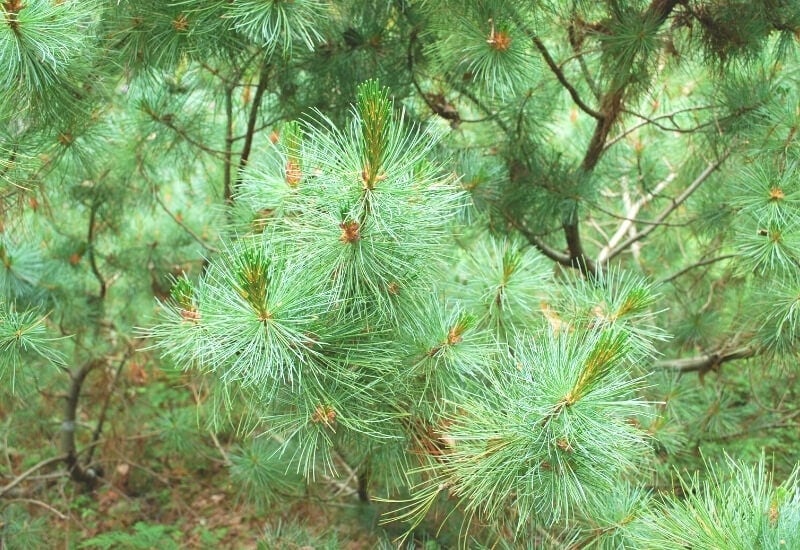
Mugo pine comes in a few different varieties. In the wild, many versions of this evergreen take the form of a broad tree. However, even in nature, low-spreading forms are more common.
Dwarf mugo pine shares this low growth habit but has a smaller size. The variety called ‘Aurea’ reaches only 3 feet and has attractive bright green needles.
These come in sets of 2 and are around 3 inches long. In fall they become more yellow and sometimes have a semi-evergreen quality.
The form of this small evergreen shrub is coarse and irregular. Its branches have a dense habit and rough scaly grey-brown bark.
Growing Conditions
As the hardiness rage implies, dwarf mugo pine performs best in cooler climates. In those settings, it can survive both sandy and clay soils. The only thing to avoid is poor drainage. Also, the more sun exposure this plant receives, the more yellow the needles will be.
Care Requirements
Dwarf mugo pine can have a few pest problems. This is especially true when this plant grows in the warmer parts of its range. Pruning should take place in late winter but is not always necessary for this plant.
9: Picea Pungens ‘Glauca Globosa’ (Dwarf Globe Blue Spruce)
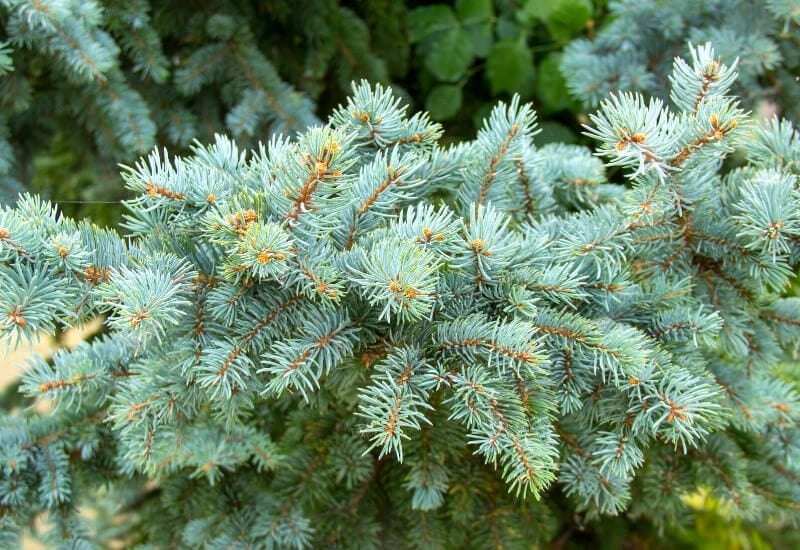
Dwarf globe blue spruce is a cultivar of the much larger blue spruce species. While the parent species soars into the sky with a distinct pyramidal form, this variety has a much different 5 foot mature size.
‘Glauca Globosa’ forms a small evergreen shrub with a nearly perfect spherical shape. This form consists of horizontal and vertical branches holding stiff needles.
The needles add aesthetic value through their color. This color is a vibrant light blue in all parts of the year. Each needle is less than 2 inches long and is sharp to the touch.
Dwarf globe blue spruce also has neat brown cones. These have a cylindrical shape and an overall length of around 4 inches.
Growing Conditions
You should plant dwarf globe blue spruce in a slightly acidic soil in full sunlight. Soils with moderate moisture and a high amount of nutrients are best. When establishing this plant give plenty of water in the first few years.
Care Requirements
Dwarf globe blue spruce has a slow growth habit that reduces the need for frequent pruning. Yet to maintain the perfect rounded form, it is sometimes necessary to remove some of the more vertical branches.
10: Taxus × Media ‘Densiformis’ (Anglo-Japanese Yew)
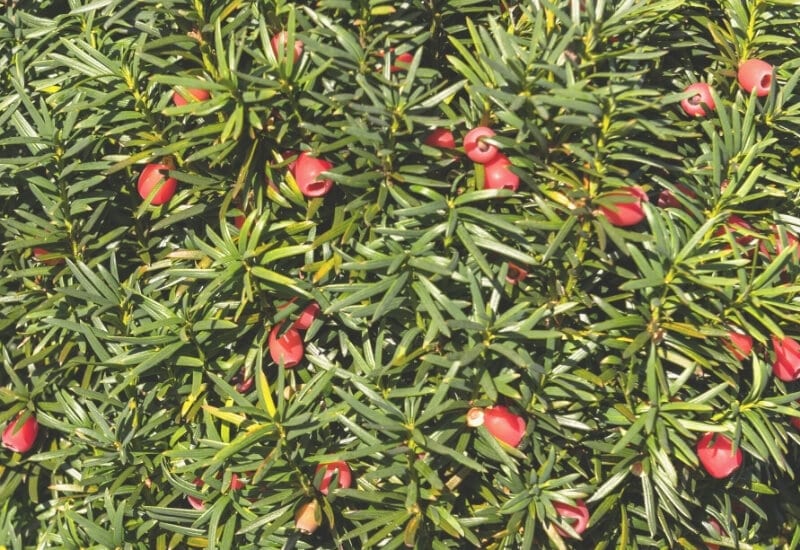
Anglo-Japanese yew is one of many hybrid crosses of English yew and Japanese yew. This cross gives this evergreen shrub its common name and a beneficial mixture of traits.
These qualities include the desirable visual appearance of English yew and the toughness of Japanese yew. The specific variety called ‘Densiformis’ is a female meaning that it holds fleshy bright red fruits.
The needles of this plant appear in a set of 2 and are typically less than an inch in length. They are somewhat soft and maintain a dark green color in all seasons.
Overall, this shrub has a dense spreading form that stays relatively low to the ground at about 3 feet tall. Also, be aware that all parts of this plant are poisonous when ingested.
Growing Conditions
Anglo-Japanese yew is not particular about soil acidity. It is also able to grow in the presence of urban pollution. The main requirement when choosing a planting location is good drainage. Anglo-Japanese yew can also tolerate a high amount of shade.
Care Requirements
Prune before the new growth appears in early spring. Watch out for pests such as weevils. Winter can be helpful in maintaining the health of the needles. Root rot is common when proper drainage is not present.
11: Chamaecyparis Pisifera ‘Golden Mop’ (Japanese False Cypress)
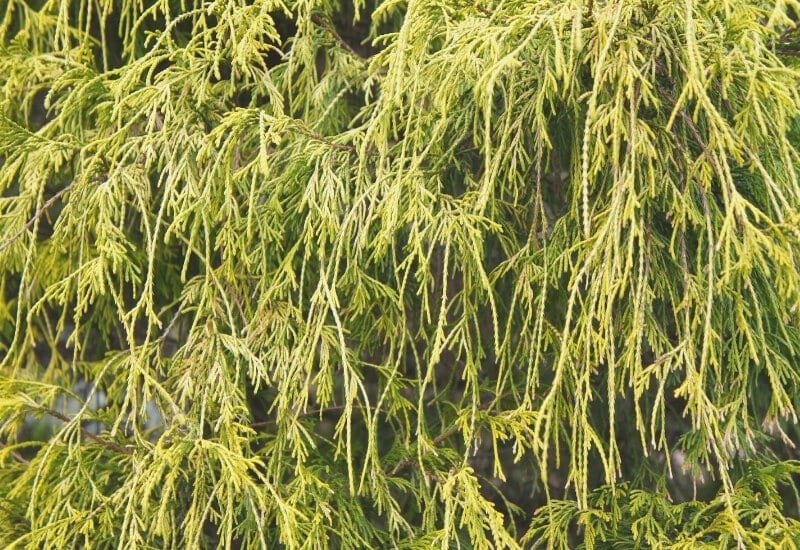
The foliage of Japanese false cypress is evergreen, flexible, and nearly weeping in its habit. It also features a vibrant color that adds to this plant’s popularity.
The needles of Japanese false cypress are a yellowish-green that borders on gold. This provides a nice accent color to the garden in all seasons.
This evergreen cultivar has a tendency to be very slow-growing. After nearly a decade, it will reach a height of 3 feet.
The ‘Golden Mop’ moniker is an homage both to the color of this dwarf plant as well as its form. The pliable foliage often looks like a wet mop.
Growing Conditions
Plant in neutral soils with part shade for the healthiest growth. Avoid wet soils and open areas where the plant will be exposed to strong winds.
Care Requirements
The ongoing care for Japanese false cypress is minimal. There are little to no pest and disease problems. Due to the small size and slow growth, pruning is often not needed.
12: Rhododendron Maximum ‘Compacta’ (Compact Rosebay Rhododendron)
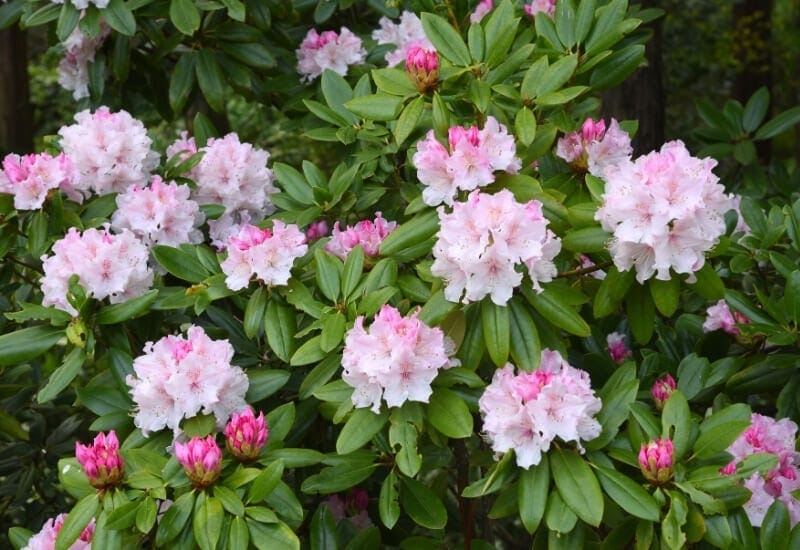
Those familiar with rhododendron will know that Rhododendron maximum is one of the largest species. However, the cultivar ‘Compacta’ rarely expands beyond 3 feet in both dimensions.
Compact rosebay rhododendron is one of few small evergreen shrubs with both appealing foliage and flowers. The leaves are broad and long with an oval shape and a dark green color.
The flowers are pale pink and bloom in multiple large clusters. These clusters appear across the entirety of this shrub in the spring.
The flowers alone are reason enough to plant this shrub. They have 5 connected petals surrounding prominent stamens. Some interior parts of the petals have a light yellow speckling.
Growing Conditions
Plan compact rosebay rhododendron in the shade of larger trees. This mimics the filtered light it loves in the wild. Acidic soils with good drainage are also essential to the health of this plant.
Care Requirements
Rhododendrons typically have an extensive root system that takes some time to establish. During this time, provide water regularly. Each year, prune and fertilize just after the plant flowers. Be sure to use an acidic fertilizer.
13: Pinus Thunbergii ‘Banshosho’ (Japanese Black Pine)
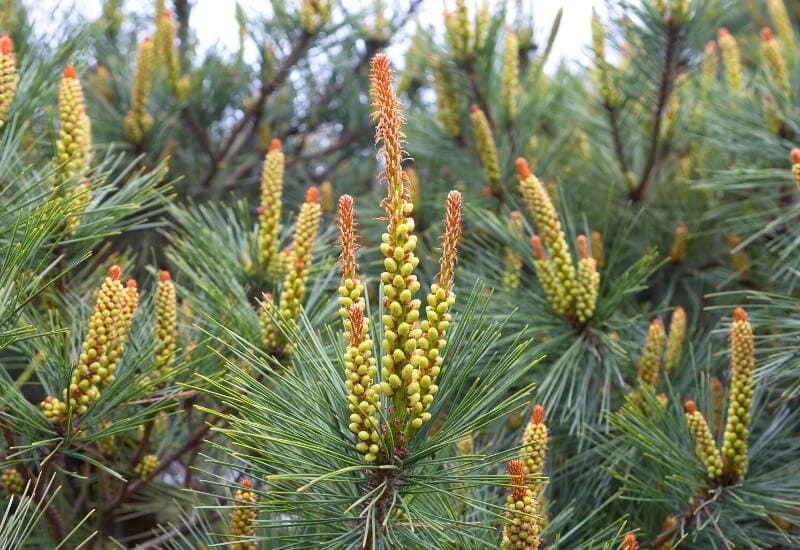
One of many Japanese black pine varieties, ‘Banshosho’ is a dwarf variety. This makes this small evergreen shrub great for small spaces and even as a bonsai tree.
This plant has a broad habit where the spread can be almost double the 3 foot height. However, it takes a while for Japanese black pine to reach its mature form. Yearly growth is limited to only a few inches.
The needles of Japanese black pine are dark green and 5 inches long. The new growth emerges in the form of a candle. These upright buds are a stark white color and eventually open into more dark needles.
This is a non-flowering plant. The majority of the intrigue for Japanese black pine comes from is small stature and contrasting foliage and new-growth candles.
Growing Conditions
Japanese black pine is salt tolerant and requires full sun. When planting, make sure you select an area with moderately moist soils. Both acidic and slightly alkaline soils are acceptable.
Care Requirements
Japanese black pine is considered invasive in some parts of the United States. So, make sure to control the spread of this plant. Pruning should take place in mid-spring with the goal of maintaining the form and size of the plant.
14: Mahonia Aquifolium ‘Compacta’ (Compact Oregon Holly Grape)
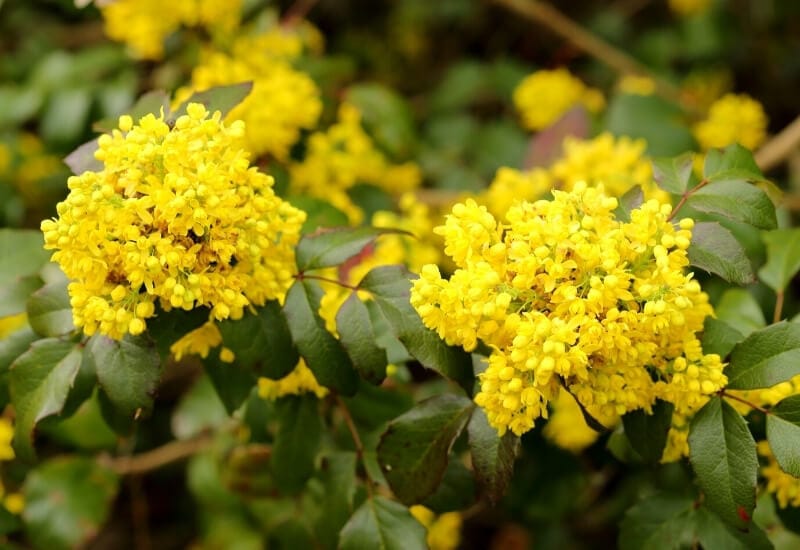
Oregon holly grape is an evergreen plant of many names. These include the common name listed here as well as, holly-leaved barberry and rocky mountain grape among many other alternatives.
More importantly, this is a highly attractive broadleaf evergreen native to the Pacific Northwest. It holds clusters of tiny yellow flowers in the spring. These lead to edible berries in summer.
The leaves share a resemblance with true holly shrubs. Mainly, they have a glossy texture and multiple sharp points at their margins.
The ‘Compacta’ variety is a cultivar bred to have a small mature size. It rarely surpasses 5 feet with its upright form.
Growing Conditions
Compact Oregon holly grape grows best in full shade to part shade. Avoid full sun and areas with strong winds. This shrub also has a liking for moist acidic soils.
Care Requirements
Compact Oregon holly grape spreads via suckering. Remove these after the shrub blooms to avoid rapid colonization. To achieve the best flowers and fruits, plant alongside other pollinator-supporting species.
15: Rhododendron ‘Robles’ ENCORE AUTUMN LILAC (ENCORE Azalea)
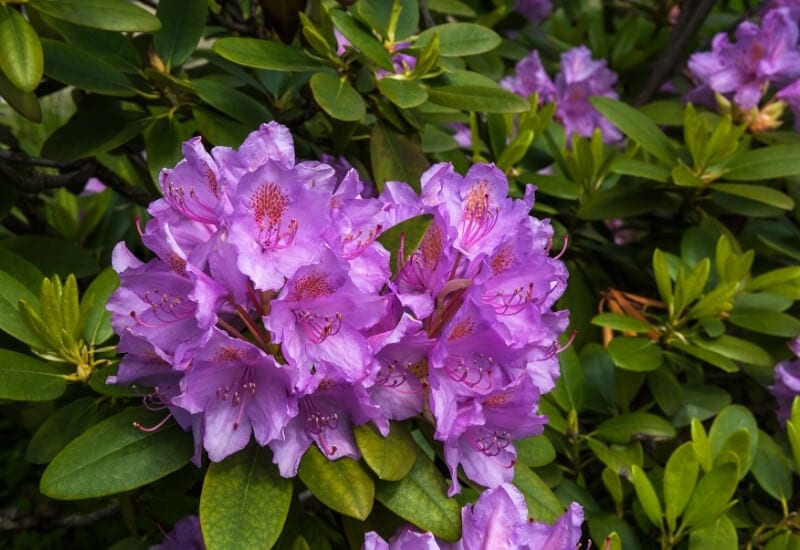
The popularity of azalea blooms has led to a proliferation of cultivars. The ENCORE group itself contains numerous varieties.
Among these is the ‘Robles’ ENCORE azalea. This is a compact broadleaf evergreen that grows to about 3 feet in height and spread. It is also known in nurseries as AUTUMN LILAC
This alternative name is due to the color of the flowers. These blooms appear in mid-spring with a purple color. As is the case with all ENCORE azaleas, this variety has the potential to bloom multiple times throughout the growing season.
This small evergreen shrub often has a multi-stemmed habit. It also has dark green leaves that serve as a good backdrop to the many blooms this shrub puts forth.
Growing Conditions
It is vital to give this azalea acidic soils and partial shade. Filtered light is ideal. Good drainage is also essential as the root system is relatively delicate and cannot survive in standing water.
Care Requirements
If your azalea is performing poorly, consider transplanting to a raised bed where you have full control over soil conditions. Azaleas can also fall victim to many pests and diseases. Prune this shrub just after the season’s first blooms fade.
Conclusion
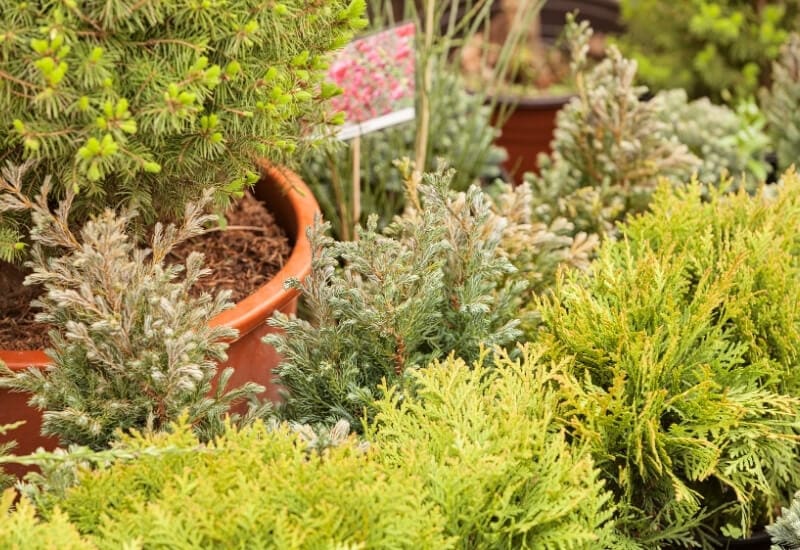
You now know about some of the best small evergreen shrub varieties. Keep in mind that there are many more options available in commercial nurseries.
Most of the species on this list have a large number of dwarf varieties. Regardless of which you choose, you must know how to establish these plants and care for them over the long term. This list will get you started.

Written By
Margie Fetchik
Margie and Arkansas native has an extensive background in gardening and landscaping. For the last 40 years, Margie has called the Colorado Rocky Mountains her home. Here she and her husband of 36 years raised three kids and owned a successful landscaping company. Margie has a CSU Master Gardener certification. She specialized in garden design & installation, perennial gardens, turf grasses & weeds, flower containers, and the overall maintenance of allHOA, commercial and residential accounts. She and her husband now reside in Denver and are excited about the new experiences’ city life holds.

Can you recommend a mounding, very shirt evergreen shrub that can take good bit of direct sun? Looking for something that can be used as a border and not too fussy. Don’t care for thuja. Thanks. [email protected]
Adam’s needle is a great evergreen plant that grows to around 4 to 8 feet tall with a 2- to 3-foot spread and can tolerate poor, sandy soil, as well as some drought.
I don’t think you know what small means. 🙁
That was exactly my thought! I came here looking for shrubs that grew a max of 2′ height and width. All of these START at least that size and go way upward and outward from there.
Exactly my thought.
Encore azaleas website says their shrubs can take full sun or part shade, but bloom best in sun. These have different sun requirements from regular azaleas. Just fyi